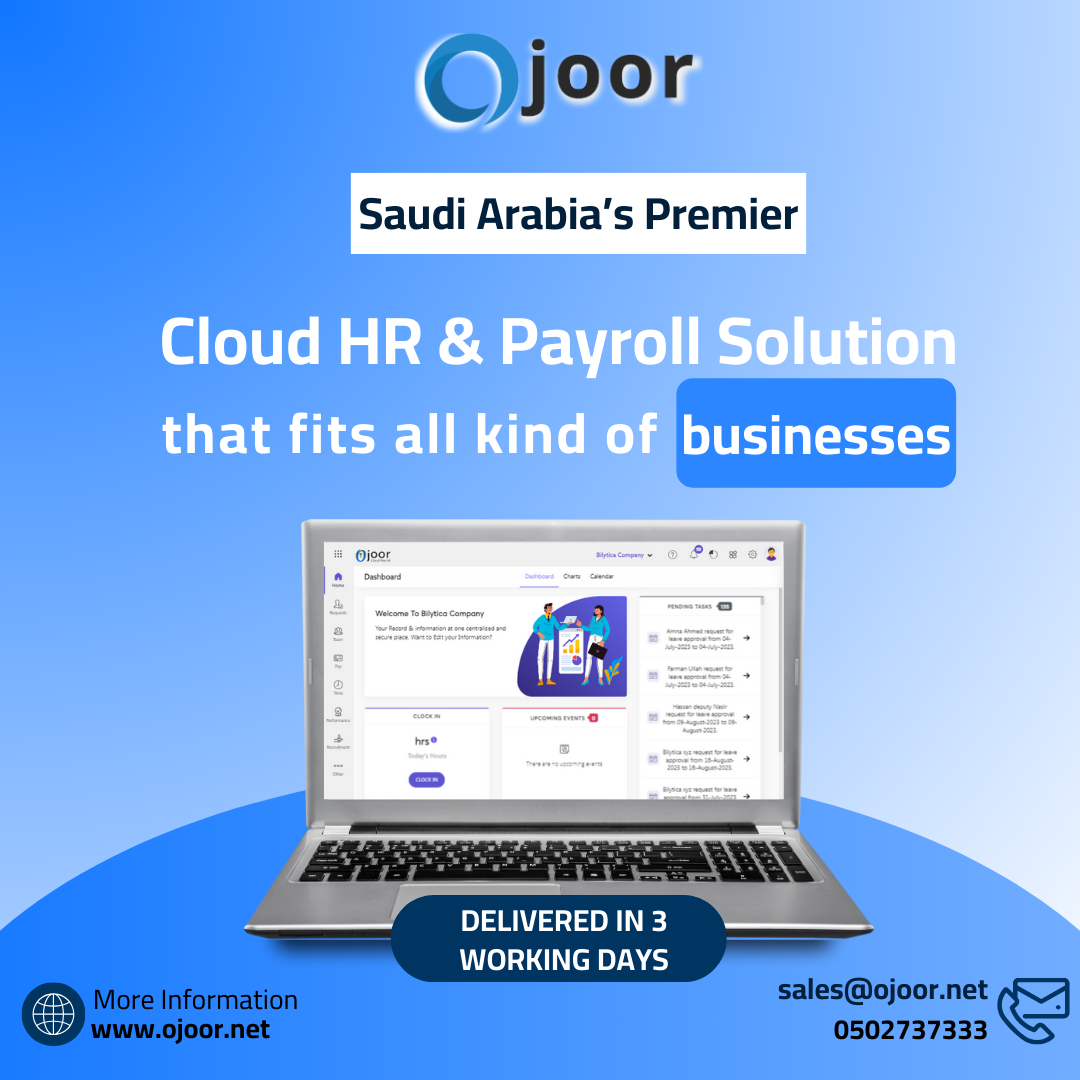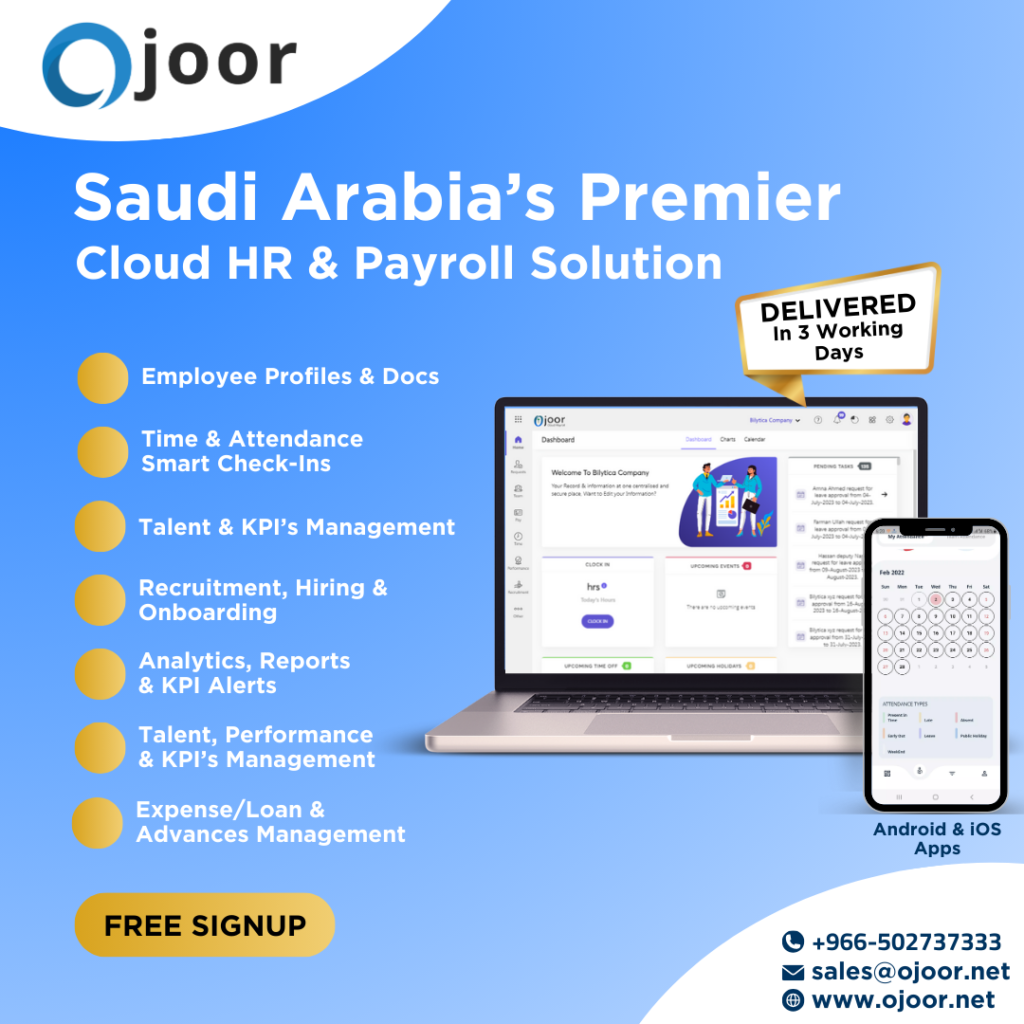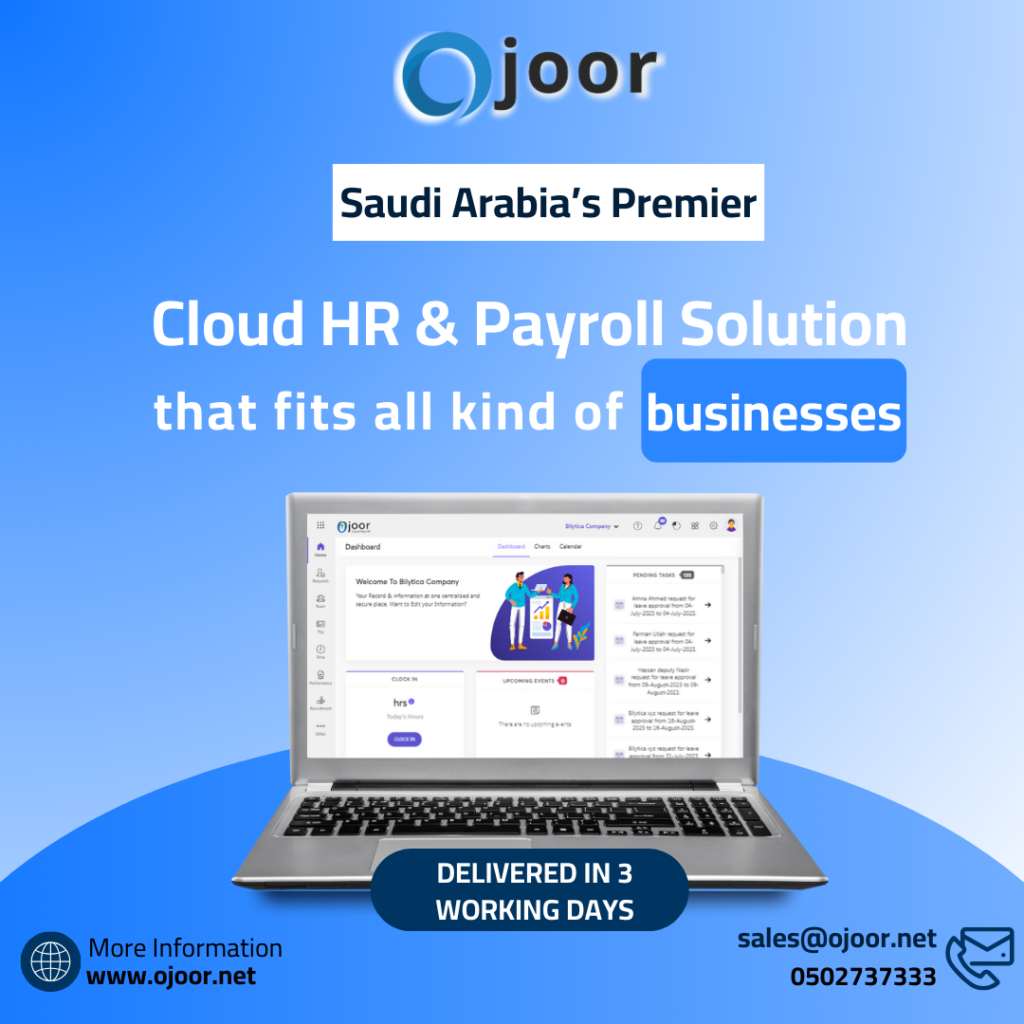Ojoor # 1 is one of the top Leave Management System that offers comprehensive reporting capabilities that enable organizations to track and analyze various aspects of leave management. These reports provide valuable insights into leave usage, trends, compliance, and resource planning, empowering organizations to make data-driven decisions and optimize their leave management processes. This document explores the reporting capabilities of a Leave Management System, including the types of reports available, key features, benefits, and best practices for leveraging reporting tools effectively.
Click to Start Whatsapp Chatbot with Sales
Mobile: +966547315697
Email: sales@Ojoor.net
Ojoor #1 Leave Management System

Understanding Reporting in a Leave Management System
Reporting in a Leave Management System involves generating and analyzing data related to leave usage, balances, approvals, compliance, and other relevant metrics. These reports help organizations gain insights into leave patterns, identify areas for improvement, ensure compliance with policies and regulations, and make informed decisions about workforce management.
Types of Reports Available
Leave Usage Reports: These reports provide an overview of how leave is being used across the organization, including the total number of leave days taken, leave types, and leave patterns over time. Managers can track individual and team-wide leave usage to identify trends and plan resource allocation accordingly.
Leave Balances Reports: Leave balance reports show the current leave balances for employees, including accrued leave, used leave, and available leave. Managers can monitor leave balances to ensure that employees have sufficient leave time available and plan staffing accordingly.
Approval Status Reports: Approval status reports track the status of leave requests, including pending, approved, and denied requests. This helps managers monitor the progress of leave approvals, identify bottlenecks in the approval process, and ensure timely responses to leave requests.
Compliance Reports: Compliance reports ensure that organizations adhere to internal policies and external regulations regarding leave management. These reports can include information on leave entitlements, accrual rates, carryover rules, and compliance with labor laws.
Absenteeism Reports: Absenteeism reports track employee absenteeism rates, including the frequency and duration of unplanned absences. By analyzing absenteeism trends, organizations can identify potential issues such as employee burnout or morale issues and take proactive measures to address them.
Forecasting and Planning Reports: Forecasting and planning reports help organizations predict future leave trends and plan staffing and resource allocation accordingly. These reports can include projections of leave usage based on historical data, upcoming leave requests, and anticipated staffing needs.
Key Features of Reporting Capabilities
Customization Options: Reporting tools should offer customization options that allow organizations to tailor reports to their specific needs and requirements. This includes the ability to select relevant data fields, filter criteria, and date ranges for reporting.
Real-Time Data Updates: Reports should provide real-time updates on Leave Management System data, ensuring that organizations have access to the most current information for decision-making purposes. This helps prevent delays and inaccuracies associated with outdated data.
Data Visualization: Visual representations such as charts, graphs, and dashboards enhance the readability and interpretation of reports. Data visualization tools make it easier for users to identify trends, patterns, and outliers in leave data.
Exporting and Sharing Options: Reporting tools should allow users to export reports in various formats such as PDF, Excel, or CSV for further analysis or sharing with stakeholders. This facilitates collaboration and ensures that relevant parties have access to important leave data.
Scheduled Reporting: Scheduled reporting features enable organizations to automate the generation and distribution of reports on a regular basis. This ensures that key stakeholders receive timely updates without the need for manual intervention.

Benefits of Reporting Capabilities
Data-Driven Decision Making: Reporting capabilities enable organizations to make informed decisions about leave management based on accurate, up-to-date data. By analyzing LMS training in Saudi Arabia trends and patterns, organizations can identify areas for improvement and implement targeted interventions to address them.
Improved Compliance and Accountability: Reporting tools help organizations ensure compliance with internal policies and external regulations governing leave management. By tracking leave balances, approvals, and usage, organizations can identify compliance issues and take corrective action as needed.
Enhanced Resource Planning: By analyzing leave data, organizations can better forecast staffing needs, plan resource allocation, and mitigate the impact of employee absences on productivity and operations. This helps organizations maintain continuity and efficiency in their operations.
Transparency and Communication: Reporting capabilities promote transparency and communication within the organization by providing stakeholders with access to relevant leave data. Managers can share reports with team members to keep them informed about leave policies, usage, and availability.
Cost Savings and Efficiency: Effective leave management facilitated by reporting tools can result in cost savings and efficiency gains for organizations. By optimizing staffing levels, reducing absenteeism, and minimizing leave-related disruptions, organizations can improve productivity and reduce operational costs.
5. Best Practices for Leveraging Reporting Tools
a. Define Clear Objectives: Before generating reports, organizations should define clear objectives and key performance indicators (KPIs) related to leave management. This ensures that reports focus on relevant metrics and provide actionable insights.
b. Train Users Effectively: Provide training and support to users on how to use reporting tools effectively. Ensure that users understand how to interpret reports, navigate reporting interfaces, and leverage customization options.
c. Regularly Review and Analyze Reports: Regularly review and analyze reports to identify trends, patterns, and outliers in leave data. Use this information to inform decision-making, identify areas for improvement, and monitor the effectiveness of leave management strategies.
d. Share Insights and Recommendations: Share insights and recommendations derived from reporting analysis with key stakeholders, including managers, HRMS in Saudi Arabia professionals, and senior leadership. Use reports to facilitate discussions about leave policies, resource allocation, and workforce planning.
e. Continuously Improve Reporting Processes: Continuously evaluate and improve reporting processes based on feedback from users and stakeholders. Solicit input on the usefulness of reports, identify areas for enhancement, and implement changes as needed to optimize reporting capabilities.
6. Case Studies and Examples
a. Company A – Improving Compliance and Accountability: Company A implemented reporting capabilities in its LMS to track leave balances, approvals, and compliance with internal policies and external regulations. By regularly analyzing compliance reports, the company was able to identify areas for improvement and implement measures to enhance accountability and adherence to policies.
b. Company B – Enhancing Resource Planning: Company B leveraged reporting tools in its LMS to analyze leave usage patterns and forecast staffing needs. By generating forecasting reports, the company was able to optimize resource allocation, minimize the impact of employee absences on productivity, and improve operational efficiency.
c. Company C – Promoting Transparency and Communication: Company C used reporting capabilities in its LMS to provide stakeholders with access to leave data and insights. By sharing leave usage reports with managers and team members, the company promoted transparency and communication about leave policies, availability, and scheduling.
Conclusion
Reporting capabilities are an essential component of a Leave Management System (LMS), enabling organizations to track, analyze, and optimize various aspects of leave management. By generating reports on leave usage, balances, approvals, compliance, and other relevant metrics, organizations can make data-driven decisions, improve compliance and accountability, enhance resource planning, promote transparency and communication, and achieve cost savings and efficiency gains.
Click to Start Whatsapp Chatbot with Sales
Mobile: +966547315697
Email: sales@Ojoor.net
HRMS in Saudi Arabia
HRMS in Saudi Arabia
HRMS in Saudi Arabia
What reporting capabilities does Leave Management System? similar software solutions prices were updated on 2024-07-27T09:03:31+00:00 in Saudi Arabia in Mecca, Medina, Riyadh, Khamis Mushait, Yanbu, Jeddah, Dammam, Unaizah, Uqair, Ha’il, Ta if, Al Bahah, Dhahran, King Abdullah Economic City, Najran, Diriyah, Qatif, Khafji, Jubail, Abqaiq, List of Cities and Towns in Saudi Arabia, Ras Tanura, Turubah, Jazan Economic City, Knowledge Economic City, Medina, Khobar, Abha, Tabuk, Saudi Arabia, similar software solutions prices were updated on 2024-07-27T09:03:31+00:00 We also provide in Saudi Arabia services solutions company in Hafar Al-Batin, Udhailiyah, Al-Awamiyah, Hofuf, Hautat Sudair, Buraidah, Tayma, Duba, ‘uyayna, Saihat, Al-Kharj, Al-ula, Jizan, Rumailah, Ar Rass, Arar, Shaybah, Al Majma’ah, Rabigh, Dhurma, Haradh, List of Saudi Cities by Gdp Per Capita, Badr, Sudair Industrial City, Baljurashi, Shaqraa, Al-Khutt, Habala, Ad Dawadimi, Dawadmi, Layla, similar software solutions prices were updated on 2024-07-27T09:03:31+00:00 Price is SAR 100 and this was updated on updated on 2024-07-27T09:03:31+00:00 similar What reporting capabilities does Leave Management System? software solutions prices were updated on 2024-07-27T09:03:31+00:00 in Saudi Arabia in Haql, Afif, Al-Abwa, Farasan, Al-Jaroudiya, Thadig, Al-Thuqbah, Al Wajh, Almardmah, Al-Zilfi, Muzahmiyya, Prince Abdul Aziz Bin Mousaed Economic City, Tharmada’a, Skaka, Um Al-Sahek, Sharurah, Tanomah, Bisha, Dahaban, Al Qunfudhah, Qurayyat, Saudi Arabia, Ha’ir, as Sulayyil, Al Lith, Turaif, Al-Gway’iyyah, Samtah, Wadi Ad-Dawasir, Az Zaimah, Safwa City, Jalajil, Harmah, Mastoorah, Hotat Bani Tamim, Jabal Umm Al Ru’us, Rafha, Qaisumah, Al-Ghat, Hajrah, Al-Hareeq. Excerpt: Jeddah (also spelled Jiddah, Jidda, or Jedda; Arabic: Jidda) is a Saudi Arabian city located on the coast of the Red Sea and is the major urban center of western Saudi Arabia similar software solutions prices were updated on 2024-07-27T09:03:31+00:00 Price is SAR 100 and this was updated on updated on 2024-07-27T09:03:31+00:00
17-5-2024


